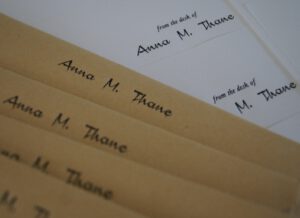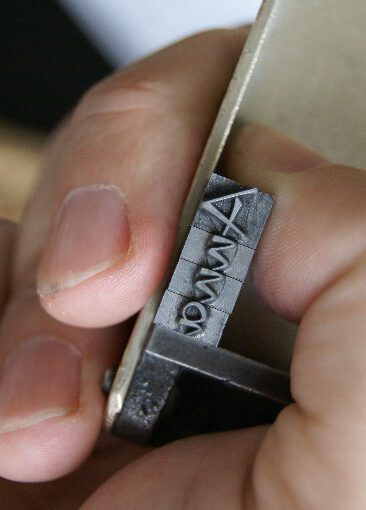An exhibition by Matthias Adler
Foreword by Anna M. Thane
 A fashionable household of the Regency period had a great demand for printed products. There were, of course, books, magazines and prints, but also calling cards, invitation cards and pre-printed letterheads.
A fashionable household of the Regency period had a great demand for printed products. There were, of course, books, magazines and prints, but also calling cards, invitation cards and pre-printed letterheads.
Calling cards were important social tools. An engraved card was considered to have the most distinguished style, but a nicely printed card was also appropriate. A calling card bore the visitor’s name, title and residence. A printed letterhead was used for official communication. Even the middle classes – traders and businessmen – used pre-printed official paper since the late 18th century.
Imagine my delight when I received a special gift: my personal stationery with letterhead. It was even printed in the traditional way, by using a printing press. Amazing!
It certainly is a special treat for every Regency enthusiast to have or even print one’s personal letters, calling cards, invitations or small books. The exhibition “Kiss” or “Smack” by Matthias Adler provides an insight into the production steps and will certainly inspire you to try your hand on historical printing.
Enjoy the exhibition!
Anna M. Thane
______________________________________________________________________________
“Kiss” or “Smack” by Matthias Adler
How to print your personal letterhead
Choosing paper and ink
“Form follows function”: This idea also goes for letterpress printing. So when a printing project evolves, careful decisions have to be made concerning not only the text to be printed, but also paper, printing ink and typeface. A wide range of excellent printing paper is available in specialty stores. Whereas thick cotton paper might be used for stylish wedding invitations, the paper for letterhead should be lighter, easy to fold and – as you surely want to write on such handcrafted letterhead with your fountain pen – suitable for writing with ink. Printing ink comes in a variety of colours, and eco-friendly printing inks without solvents are on sale as well.
______________________________________________________________________________
Traditional printing techniques at home
Lately, an old craft got once again into the general focus of people: the art of letterpress printing.
Copying books used to be time-consuming work in old times, until around 1440 Johannes Gutenberg invented movable, reusable type that could easily be used for forming words and sentences. He also invented a printing press that reminds of a wine press: the type was inked, a sheet of paper put on it, the whole form was slit under the press which put the necessary pressure on to ensure a smooth transition of the ink from the type to the paper.
(I am well aware that moveable type had already been developed in Korea about 50 years before Gutenberg came up with his invention. But imagining old Gutenberg having a few glasses of the local wine and making up his mind about alternative usage of a wine press is more pleasing.)
C
This revolutionary technique turned out to be used for centuries with improvements here and there (for instance type setting machines) until soon afte World War II phototypesetting emerged. Phototypesetting was by far more convenient than setting type – just imagine that you no longer needed lead type in various sizes and typefaces, not to speak of purchasing and storing huge amounts of type. “Heavy metal” lost its meaning, so to speak … So in the late 1970s, there was no use of the old equipment any more. Workshops got rid of their type and their printing presses. And as a result, also knowledge and skills were about to vanish, but managed to survive somehow in a very few printing shops that manufactured expensive and exquisite calling cards and letterhead for a few distinguished clients. When online printing shops on the internet appeared that allowed everyone to have some business cards or leaflets printed for small money, this seemed to be the deathblow to the historic craft. But at the same time more and more people started holding traditional crafts in high esteem. This countermovement led to the foundation of quite a lot of workshops, first in the US, but lately also in good old Europe.

Lead type comes in different typefaces and sizes. Such a type case holds only one size of one specific typeface. And it is heavy, really heavy…
Of course the old traditional craft has been combined with modern techniques using computers for designing all kind of printed material. The design is then transferred to photopolymer plates and printed on old presses. Modern printers cater for the taste and needs of modern people who like the visual and tactile quality of printed material used for occasions like weddings, baby showers and other special events that ask for something exceptional. So thick cardstock is used today for printing with various colours and deep indentations caused by high pressure: “Smack!” The traditional printers still prefer the soft “kiss”, hardly touching the paper. Their only favourite colour is – of course – black.
Everyone can have a try at practicing this craft. Quite a few workshops offer classes for setting type and printing one´s own postcards, letterhead or business cards. Those places usually offer lots of different lead type and also wood type in various sizes, styles and typefaces. Many kinds of paper are available, and someone who is competent to answer all related questions and introduce you to a new world.
For those who might choose letterpress printing as a hobby, printing presses and equipment may be purchased via specialized dealers or you might try your luck on eBay. As presses and type are looked for lately, they tend to be overprized. Look out for quality and ask a specialist in case you are going to purchase a press. At first, a small press like the famous “Adana 5×8” might do, a small choice of lead type will already enable you to produce beautiful results.
The Yellow Pages of www.briarpress.org enable you to search for museums, organizations, classes and suppliers all over the world. In addition, you will find hundreds of private presses that show their products on their websites and write about their businesses in their blogs.
Just a few words about myself: holding a diploma in translation (Japanese/Korean) and having a weakness for high-quality paper products, turning to letterpress printing was rather unavoidable. Doing rather small jobs right now (letterhead, postcards and the like), I am dreaming of bigger projects like translating short stories, printing them and binding the sheets in small books … Well, this seems to be just a matter of time …
So far, Matthias has translated the following books into German:
“Shinjuku Paradise” by Hideo Levy
“Ein Hund aus Flandern” by Marie Louise de la Ramée
“Warum ich Frauen trotzdem mag” by Beat Takeshi (team of two translators)
Go to the main page of the Museum of Creativity.
Go to the blog.






